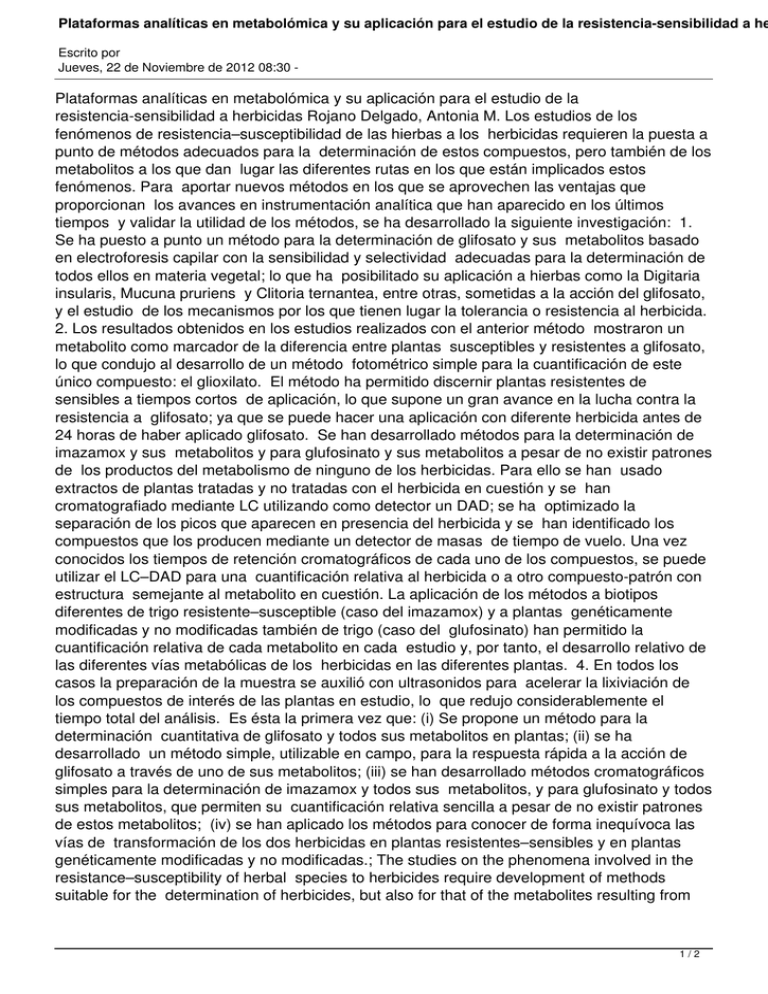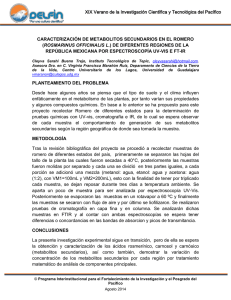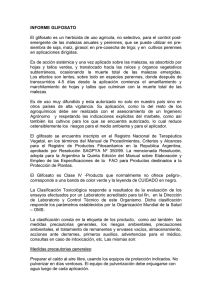Documento 1944540
Anuncio

Plataformas analíticas en metabolómica y su aplicación para el estudio de la resistencia-sensibilidad a he Escrito por Jueves, 22 de Noviembre de 2012 08:30 - Plataformas analíticas en metabolómica y su aplicación para el estudio de la resistencia-sensibilidad a herbicidas Rojano Delgado, Antonia M. Los estudios de los fenómenos de resistencia–susceptibilidad de las hierbas a los herbicidas requieren la puesta a punto de métodos adecuados para la determinación de estos compuestos, pero también de los metabolitos a los que dan lugar las diferentes rutas en los que están implicados estos fenómenos. Para aportar nuevos métodos en los que se aprovechen las ventajas que proporcionan los avances en instrumentación analítica que han aparecido en los últimos tiempos y validar la utilidad de los métodos, se ha desarrollado la siguiente investigación: 1. Se ha puesto a punto un método para la determinación de glifosato y sus metabolitos basado en electroforesis capilar con la sensibilidad y selectividad adecuadas para la determinación de todos ellos en materia vegetal; lo que ha posibilitado su aplicación a hierbas como la Digitaria insularis, Mucuna pruriens y Clitoria ternantea, entre otras, sometidas a la acción del glifosato, y el estudio de los mecanismos por los que tienen lugar la tolerancia o resistencia al herbicida. 2. Los resultados obtenidos en los estudios realizados con el anterior método mostraron un metabolito como marcador de la diferencia entre plantas susceptibles y resistentes a glifosato, lo que condujo al desarrollo de un método fotométrico simple para la cuantificación de este único compuesto: el glioxilato. El método ha permitido discernir plantas resistentes de sensibles a tiempos cortos de aplicación, lo que supone un gran avance en la lucha contra la resistencia a glifosato; ya que se puede hacer una aplicación con diferente herbicida antes de 24 horas de haber aplicado glifosato. Se han desarrollado métodos para la determinación de imazamox y sus metabolitos y para glufosinato y sus metabolitos a pesar de no existir patrones de los productos del metabolismo de ninguno de los herbicidas. Para ello se han usado extractos de plantas tratadas y no tratadas con el herbicida en cuestión y se han cromatografiado mediante LC utilizando como detector un DAD; se ha optimizado la separación de los picos que aparecen en presencia del herbicida y se han identificado los compuestos que los producen mediante un detector de masas de tiempo de vuelo. Una vez conocidos los tiempos de retención cromatográficos de cada uno de los compuestos, se puede utilizar el LC–DAD para una cuantificación relativa al herbicida o a otro compuesto-patrón con estructura semejante al metabolito en cuestión. La aplicación de los métodos a biotipos diferentes de trigo resistente–susceptible (caso del imazamox) y a plantas genéticamente modificadas y no modificadas también de trigo (caso del glufosinato) han permitido la cuantificación relativa de cada metabolito en cada estudio y, por tanto, el desarrollo relativo de las diferentes vías metabólicas de los herbicidas en las diferentes plantas. 4. En todos los casos la preparación de la muestra se auxilió con ultrasonidos para acelerar la lixiviación de los compuestos de interés de las plantas en estudio, lo que redujo considerablemente el tiempo total del análisis. Es ésta la primera vez que: (i) Se propone un método para la determinación cuantitativa de glifosato y todos sus metabolitos en plantas; (ii) se ha desarrollado un método simple, utilizable en campo, para la respuesta rápida a la acción de glifosato a través de uno de sus metabolitos; (iii) se han desarrollado métodos cromatográficos simples para la determinación de imazamox y todos sus metabolitos, y para glufosinato y todos sus metabolitos, que permiten su cuantificación relativa sencilla a pesar de no existir patrones de estos metabolitos; (iv) se han aplicado los métodos para conocer de forma inequívoca las vías de transformación de los dos herbicidas en plantas resistentes–sensibles y en plantas genéticamente modificadas y no modificadas.; The studies on the phenomena involved in the resistance–susceptibility of herbal species to herbicides require development of methods suitable for the determination of herbicides, but also for that of the metabolites resulting from 1/2 Plataformas analíticas en metabolómica y su aplicación para el estudio de la resistencia-sensibilidad a he Escrito por Jueves, 22 de Noviembre de 2012 08:30 - the different metabolic pathways involved in these phenomena. With the aim of developing new methods which take advantage of the cutting-edge advances in analytical instrumentation and assessing their usefulness, the following research has been carried out: 1.A method for the determination of glyphosate and its metabolites has been developed, which is based on capillary electrophoresis and is endowed with the appropriate selectivity and sensitivity for determination of all them in vegetal material. The method has been applied to herbals such as Digitaria insularis, Mucuna pruriens and Clitoria ternantea, among others, subjected to glyphosate action, as well as to the study of the mechanisms through which either the tolerance or resistance to the herbicide takes place. 2.The results from the above studies showed a metabolite as biomarker of the difference between susceptible and resistant plants; thus leading to the development of a simple photometric method for quantitation of this single compounds: glyoxilate. The method has made possible short-time discrimination between resistant and sensitive plants before 24 h application of glyphosate. 3.Methods for the determination of imazamox and its metabolites, as well for glufosinate and its metabolites have been developed, despite the absence of available standards of these metabolic products. For the development of the methods, extracts from plants treated and nontreated with the target herbicide have been used; extracts which have been subjected to chromatography by LC using a DAD as detector; the separation among the peaks appeared in the presence of the herbicide has been optimized and the compounds which provide the peaks have been identified by a mass time-of-flight detector. Once the chromatographic retention time for each of the compounds has been known, the LC–DAD system can be used for quantitation of them relative to either the herbicide or other standard compound with structure similar to that of the target metabolite. The application of the methods to different biotypes of resistant– susceptible wheat (subjected to imazamox) and to genetically modified and unmodified wheat (subjeted to glufosinate) has allowed relative quantitation of each metabolite in each of the studies and, therefore, to know the relative development of the different metabolic pathways of the herbicides in the different plants. 4. In all cases, sample preparation has been assisted by ultrasound to accelerate the leaching step of the target compounds from the plants under study; thus decreasing drastically the total analysis time. This is the first time that: (i) a method is proposed for the quantitative determination of glyphosate and all its metabolites in plants; (ii) a method simple, for in field use and with short-time response to the action of glyphosate through one of its metabolites (glyoxilate) has been reported; (iii) simple chromatographic methods for the determination of imazamox and all its metabolites, and for glufosinate and all its metabolites have been developed —the methods allow relative quantitation of the metabolites despite there are not available standards for them—; (iv) the methods thus developed have been applied to know, in an unequivocal manner, the metabolic pathways of the two herbicides in resistant– sensitive plants and in genetically modified and unmodified plants. Lee el articulo completo 2/2

